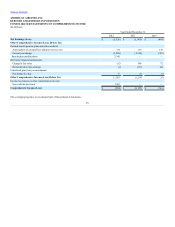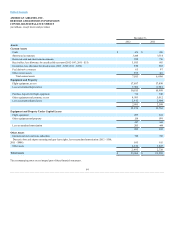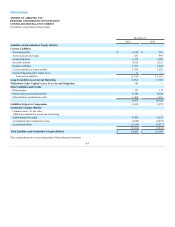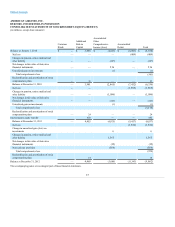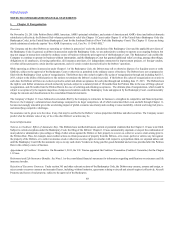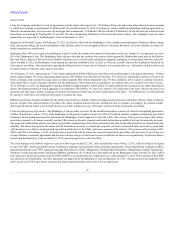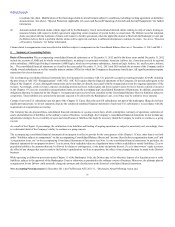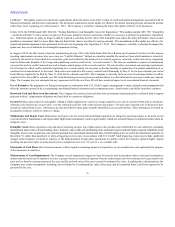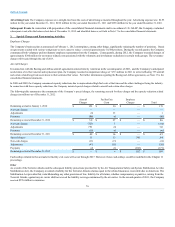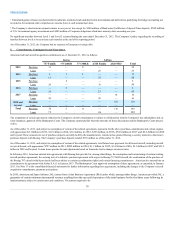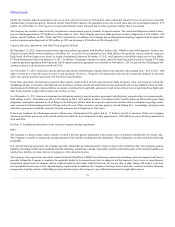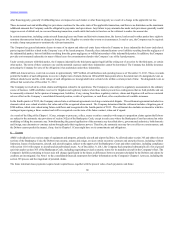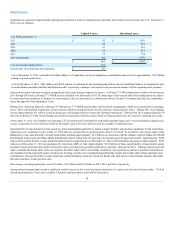American Airlines 2012 Annual Report Download - page 73
Download and view the complete annual report
Please find page 73 of the 2012 American Airlines annual report below. You can navigate through the pages in the report by either clicking on the pages listed below, or by using the keyword search tool below to find specific information within the annual report.
Table of Contents
to estimate the claim. Modifications of the financings related to aircraft remain subject to conditions, including reaching agreement on definitive
documentation. See above, “Special Protection Applicable to Leases and Secured Financing of Aircraft and Aircraft Equipment,” for further
information.
(2) Amounts include allowed claims (claims approved by the Bankruptcy Court) and estimated allowed claims relating to entry of orders treating as
unsecured claims with respect to facility agreements supporting certain issuances of special facility revenue bonds. The Debtors record an estimated
claim associated with the treatment of claims with respect to facility agreements when the applicable motion is filed with the Bankruptcy Court and
the Debtors believe that it is probable that the motion will be approved, and there is sufficient information to estimate the claim. See above, “Rejection
of Executory Contracts,” for further information.
Claims related to reorganization items are reflected in liabilities subject to compromise on the Consolidated Balance Sheet as of December 31, 2012 and 2011.
2. Summary of Accounting Policies
Basis of Presentation The accompanying consolidated financial statements as of December 31, 2012 and for the three years ended December 31, 2012
include the accounts of AMR and its wholly owned subsidiaries, including (i) its principal subsidiary, American Airlines, Inc. (American) and (ii) its regional
airline subsidiary, AMR Eagle Holding Corporation (AMR Eagle), which has two primary subsidiaries, American Eagle Airlines, Inc. and Executive Airlines,
Inc. . The consolidated financial statements as of and for the years ended December 31, 2012, 2011 and 2010 include the accounts of the Company and its
wholly owned subsidiaries as well as variable interest entities (VIEs) for which the Company is the primary beneficiary. All significant intercompany
transactions have been eliminated.
The accompanying consolidated financial statements have been prepared in accordance with U.S. generally accepted accounting principles (GAAP), including
the provisions of ASC 852 “Reorganizations” (ASC 852). ASC 852 requires that the financial statements of the Company, for periods subsequent to the
filing of the Chapter 11 Cases, distinguish transactions and events that are directly associated with the reorganization from the ongoing operations of the
business. Accordingly, certain revenues, expenses (including professional fees), realized gains and losses and provisions for losses that are realized or incurred
in the Chapter 11 Cases are recorded in reorganization items, net on the accompanying Consolidated Statement of Operations. In addition, prepetition
obligations that may be impacted by the Chapter 11 reorganization process have been classified on the Consolidated Balance Sheet in liabilities subject to
compromise. These liabilities are reported at the amounts expected to be allowed by the Bankruptcy Court, even if they may be settled for lesser amounts.
Certain of our non-U.S. subsidiaries are not part of the Chapter 11 Cases. Since the non-US subsidiaries not part of the bankruptcy filing do not have
significant transactions, we do not separately disclose the condensed combined financial statements of such non-U.S. subsidiaries s in accordance with the
requirements of reorganization accounting.
The Company has also prepared these consolidated financial statements on a going concern basis, which contemplates continuity of operations, realization of
assets and satisfaction of liabilities in the ordinary course of business. Accordingly, the Company’s consolidated financial statements do not include any
adjustments relating to the recoverability of assets and classification of liabilities that might be necessary should the Company be unable to continue as a going
concern.
As a result of the Chapter 11 proceedings, the satisfaction of our liabilities and funding of ongoing operations are subject to uncertainty and, accordingly, there
is a substantial doubt of the Company’s ability to continue as a going concern.
The accompanying consolidated financial statements do not purport to reflect or provide for the consequences of the Chapter 11 Cases, other than as set forth
under “liabilities subject to compromise” on the accompanying Consolidated Balance Sheets and “income (loss) before reorganization items, net” and
“reorganization items, net” on the accompanying Consolidated Statements of Operations (see Note 1 to the consolidated financial statements). In particular, the
financial statements do not purport to show (1) as to assets, their realizable value on a liquidation basis or their availability to satisfy liabilities; (2) as to
prepetition liabilities, the amounts that may be allowed for claims or contingencies, or the status and priority thereof; (3) as to shareowners’ equity accounts,
the effect of any changes that may be made to the Debtors' capitalization; or (4) as to operations, the effect of any changes that may be made to the Debtors'
business.
While operating as debtors-in-possession under Chapter 11 of the Bankruptcy Code, the Debtors may sell or otherwise dispose of or liquidate assets or settle
liabilities, subject to the approval of the Bankruptcy Court or otherwise as permitted in the ordinary course of business. Moreover, the ultimate plan of
reorganization for the Debtors could materially change the amounts and classifications in the historical consolidated financial statements.
New Accounting Pronouncements In December 2011, the FASB issued ASU 2011-11, “Disclosures About Offsetting Assets and
73


